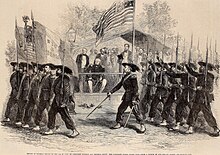Nyctitheriidae
Nyctitheriidae| Nyctitheriidae 시간 범위: 초기 Paleocene–Early 올리고세 PreꞒ Ꞓ OSDCPTJKPg N. | |
|---|---|
 | |
| 이빨의 SEM 이미지와 Asionyctia guoi의 턱 조각이다. Missiaen와 스미스는, 2005년부터. | |
| 과학적 분류 | |
| 왕국: | |
| Phylum: | |
| 등급: | |
| 순서: | |
| 패밀리: | †Nyctitheriidae |
| Subfamilies | |
| |
Nyctitheriae는 북아메리카와 아시아의 Paleocene과 Eocene 시대로부터 알려진 멸종된 illipotyphlan 살충제의 일종으로 유럽의 올리고세까지 지속되고 있다. 비록 가족이 오일리포틸라 순서로 배치되는 경우가 더 많지만, 닉티히움, 패러독스틱테리스, 와이오닉테리스 등 몇몇 제네랄은 처음에 박쥐로 묘사되었다.
기원과 발견
O.C. Marsh는 원래 와이오밍의 Eocene에서 온 Nyctitherium을 치아의 유사성에 근거한 초기 박쥐라고 묘사했다.[1] 1872년 이후, 니크티테리드의 다른 24개 이상의 성종이 명명되었고, 이 중 몇 개도 처음에는 박쥐로 여겨졌다.[2][3] G.G. 심슨은 Nyctitherium이 박쥐를 대표하지 않는다는 것을 인식했고, 1928년에 Nyctitherium과 몇몇 다른 작은 곤충들을 위해 Nyctitheriae과라고 이름 지었다.[4]
이후 수십 년 동안 아시아, 유럽, 북아메리카에서 온 많은 추가 종의 Nyctitheriae가 인정되었다. 대부분의 종은 고립된 치아와 턱 조각으로만 알려져 있지만, 크립토토포스, 유로닉티아, 플라기옥테노돈, 스크래바 등의 종은 몇몇 종후 뼈에서 알려져 있다.[5][6]
진화관계
후커(2001, 2014년)가 대신 유아콘타와의 관계를 위해 사지 뼈의 유사점을 근거로 논쟁을 벌였지만 최근의 위생학적 분석은 Nyctitheriae를 오일리포틀라 안에 배치했다.[5][7][6]
로파틴(2006)은 닉티테리과의 5개 하위 가족을 인정했다. 암피도조테리나과, 아시온옥티나과, 어소리아돈티나과, ny티테리나과, 프롤레스티나과.[8] 수염과 도슨(2009)은 이전에 더모프테라와 관련이 있다고 생각되었던 태반동물을 닉티테리과 내의 하위 가족을 나타내는 것으로 여겼다.[9] 많은 Nyctitheried 종에 대한 계통발생학적 분석은 Nyctitheriae가 대부분 단핵생물이지만 몇몇 하위가족과 일반은 그렇지 않다고 결정했다. 특히 종족인 렙타코돈과 새턴티니아뿐만 아니라 아비도조테리아나아과, 아시온옥티니아아과, 니크티테리니아아과에서도 파라피알레틱이 검출되었다.[10]
참조
- ^ Marsh, O. C. (1872-09-01). "Preliminary description of new Tertiary mammals". American Journal of Science. s3-4 (21): 202–224. Bibcode:1872AmJS....4..202M. doi:10.2475/ajs.s3-4.21.202. ISSN 0002-9599.
- ^ Revilliod, Pierre (1922). "Contribution à l'étude des Chiroptères des terrains tertiaires. Troisième partie et fin". Abhandlungen der schweizerischen palaeontologischen geologischen Gesellschaft. 45: 133–195.
- ^ Gingerich, Philip D (1987). "Early Eocene bats (Mammalia, Chiroptera) and other vertebrates in freshwater limestones of the Willwood Formation, Clark's Fork Basin, Wyoming". University of Michigan Contributions from the Museum of Paleontology. 27: 275–320.
- ^ Simpson, George Gaylord; Brown, Barnum; Siegfriedt, J. C. F. (1928). "A new mammalian fauna from the Fort Union of southern Montana. American Museum novitates ; no. 297". hdl:2246/3165.
{{cite journal}}: Cite 저널은 필요로 한다.journal=(도움말) - ^ a b Manz, Carly L.; Chester, Stephen G. B.; Bloch, Jonathan I.; Silcox, Mary T.; Sargis, Eric J. (2015-01-31). "New partial skeletons of Palaeocene Nyctitheriidae and evaluation of proposed euarchontan affinities". Biology Letters. 11 (1): 20140911. doi:10.1098/rsbl.2014.0911. PMC 4321154. PMID 25589486.
- ^ a b Hooker, Jerry J. (2014-12-14). "New postcranial bones of the extinct mammalian family Nyctitheriidae (Paleogene, UK): Primitive euarchontans with scansorial locomotion". Palaeontologia Electronica. 17 (3): 1–79. doi:10.26879/482. ISSN 1094-8074.
- ^ Hooker, J. J. (2001-08-01). "Tarsals of the extinct insectivoran family Nyctitheriidae (Mammalia): evidence for archontan relationships". Zoological Journal of the Linnean Society. 132 (4): 501–529. doi:10.1111/j.1096-3642.2001.tb02473.x. ISSN 0024-4082.
- ^ Lopatin, A. V. (2006-05-01). "Early Paleogene insectivore mammals of Asia and establishment of the major groups of Insectivora". Paleontological Journal. 40 (3): S205–S405. doi:10.1134/S0031030106090012. ISSN 1555-6174.
- ^ Beard, K. Christopher; Dawson, Mary R. (November 2009). "Early Wasatchian Mammals of the Red Hot Local Fauna, Uppermost Tuscahoma Formation, Lauderdale County, Mississippi". Annals of Carnegie Museum. 78 (3): 193–243. doi:10.2992/007.078.0301. ISSN 0097-4463.
- ^ Manz, Carly L.; Bloch, Jonathan I. (2015-09-01). "Systematics and Phylogeny of Paleocene-Eocene Nyctitheriidae (Mammalia, Eulipotyphla?) with Description of a new Species from the Late Paleocene of the Clarks Fork Basin, Wyoming, USA". Journal of Mammalian Evolution. 22 (3): 307–342. doi:10.1007/s10914-014-9284-3. ISSN 1573-7055.


